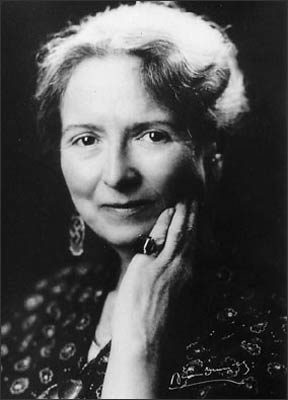Feminism and Women on the Right (Part 2)

Writing about any aspect of National Socialist Germany, or for that matter about women in Europe of the mid-thirties of the last century, poses an insurmountable problem for any objective contemporary researcher. Whether one wants to tackle the subject of horse breeding in Bavaria or the number of caged canaries in Schleswig Holstein during the Third Riech, the effects of the Gulf stream on the Spanish coast of Galicia during Franco’s rule, or the quality or wine in Tuscany during Mussolini’s rule — their prose must be subject to a strict polarity of “good democracy vs. evil fascism.”
Conceptually and verbally Nazism and Fascism have become in modern scholarship the symbols of cosmic evil. Academic presentations of any topic referring to that epoch, even if totally unrelated to politics, race or women, must be premised on forgone antifascist conclusions. Hence wine, women, birds, winds, canaries, everything smacking of the past Fascist or National Socialist epoch, must be depicted in terms of metaphysical evil. Hundreds of thousands of post-WWII academic books, dealing with the topic of Fascism and National Socialism—irrespective of their alleged academic objectivity—must contain millions of disclaimers.
This continues to the present. In order to get published, contemporary scholars dealing with that epoch must go to great lengths to spice up their prose with a flurry of antifascist qualifiers.
I have written elsewhere how modern Germany has become a laboratory of academic national-masochism, a holier-than-the-Pope case study of cultural engineering—a place where an entirely new human subspecies has been created. This has gone to the point that when one carefully observes the facial expressions of prominent German scholars in the USA, one will notice furtive and panic stricken eyes refusing any focused eye contact with the interlocutor. If one happens to blurt the word ‘Jew!’, even when talking about the gimmicks of Charlie Chaplin, or even if one ventures into disinterested historicizing of sheep grooming in Tyrol during the National Socialist epoch—it will predictably prompt the bewildered German resident scholar to start shrieking in horror and immediately vacate the premises.
German scholars are merely the most grotesque examples of this phenomenon. Abject brownnosing has become the prevailing spirit of our times, both literally and figuratively, extrapolating the academic narrative in order to best fit oneself into the safe category of the “antifa” posture. And it goes well beyone the academic world. Indeed, it has become the national sport in the elite media and political culture all over the West.
The same may be said when one studies the attitudes towards feminism and the role of women in ex-Fascist Europe, or the impressive role of women artists, scholars and soldiers in the Third Reich. The antifascist symbolism, which has been diligently handed down by liberal propaganda about carpet chewing Hitler or overweight German maids holding a cluster of newborns on their immense breasts, is still around. Short of this medical obstretic scene one can come across a pathogenetic scenario in which a seven-foot tall blonde broad, sort of a Nazi diesel dike, aka Ilse Koch, with her own suggestive family name, cooks young Jewish kids for the incoming Waffen SS meals.
Feminism and “Sexual Bolshevism”
And what did the other side have to say about feminism and “free love”? As was to be expected, early National Socialist and Fascist scholars and their sympathizers all over Europe, slammed Jewish pornography, criticized the overwhelming number of Jews in the medical profession and the movie industry in the Weimar Republic, while rejecting the liberal and Bolshevik artistic cry for “ free love.” And this was much earlier than the Frankfurt School and its European nationalist detractors came into being or appeared on the European radar screen. Thousands of books and brochures, some academic with impressive bibliography, some written in a popular propagandistic tone, attacked liberalism, cultural Marxism and the Jews, or as the late German National Socialist sexologist, Dr Ferdinand Hoffman put it, “Jewish sexual-bolshevism” (jüdischer Sexualbolschewismus, p, 55 ). Hoffman notes:
This moral decay is usually ascribed as a burden to the ever increasing civilization of European peoples and especially to our people, who seem to be always on top of everything. The emancipation of women, this typical product of the European epoch, has led, in complete disregard of the experience of motherhood, to the a rejection of children, ignoring, however, that with the decay of the family and with much vaunted rights to self-determination, women were taken away from their own fertile ground. Shrieking claims for tentative masculinization in all fields of life, including the field of eroticism, have not faded however. The freedom of the individual regarding this sensitive area is still being compared to “having total fun” (Sichausleben), whereby the marriage, let alone having children, had to play a secondary role. Sittliche Entartung und Geburtenschwund (1937, p. 15)
Most academic titles—tens of thousands of books from the fields of genetics, anthropology, but also from the fields of literature and political science—were banned by the victorious Allies in Europe, shortly after WWII. Today, scholars who do research in different areas of the National-Socialist or Fascist epoch, particularly if they deal with the tantalizing role of women, use, as noted above, the methods of “pick and chose.” In order to avoid being shut up with the classic obituary of “anti-Semite” or “fascist pig”, they must carefully make sure that their prose in no way remains unbiased and that it contains at least some sparse value judgments about the alleged morbid and criminal nature of Fascism. At best, especially when the literary and artistic achievements of “Nazi racial- feminists” are described, such as Pia Sophie Rogge-Börner or Lydia Gottschewski, or even Savitri Devi, many mainstream academics resort to parroting derisory slogans, often depicting them as a pack of libidinous sun and cat worshippers.
This continuing negative popularity of National-Socialism and Hitlerism only confirms the well founded thesis that mainstream antifascist scholars and media people are subconsciously under a spell of that bygone epoch. One can suspect that when and if different winds start blowing tomorrow in the West, their postured and faked antifascism and philo-Semitism will be replaced by vulgar anti-Semitic outbursts. Witness the recent phenomenon of Communist anti-American apparatchiks in Eastern Europe who, after the fall of the Berlin Wall, began emulating every aspect of capitalism and nodding to every wink of US foreign policy makers.
One could single out Gregor Schwartz Bostunitsch, a high ranking SS scholar of German-Russian and Serbian origin, with close ties to the German NS Ministry of Propaganda. Most of his books deal critically with Jewish attitude towards sex and the role of Jewish women in seducing and killing Gentile men, such as Esther and Judith from the Old Testament. He writes in his Jude und Weib (1939, p. 57):
Already in 1925 a National Socialist writer Herwig Harnter in his book Erotik und Rasse; Eine Untersuchung über gesellschaftliche, sittliche und geschlechtliche Frage, brought to a common denominator the Jewish attitudes toward woman. He starts from the correct standpoint: the essential issue of life is the relationship between the spiritual to the instinctive and he comes to the right conclusion: one of the most important features of Jewish sexuality consists in the fact that the Jew sees in woman primarily a gender (sex). … Here, a fundamental contrast to the Aryan man is being made who—in so far as he is healthy in his interior—searches first and foremost for a spiritual and emotional partner.
The Fascist “Femme Fatale”
Hundreds of thousands of women in National Socialist Germany and in Fascist Europe were active as artists, filmakers, actressess, or served in the military. The famous German artist Leni Riefenstahl had a decisve role in creating the National Socialist cultural iconography and she instilled into the European masses a new sense of imagery in artistic expresion—which remained strong long after WWII.
Organized womenhood of that time was not a monolithic crowd as one comes across Catholic phalangist women in Spain and “pagan” or atheist women in Germany who differed hugely from each other in their life styles. Standard feminism was officially associated with liberal anomie and Jewish inspired decadence, and therefore destructive to the European cultural heritage. In her book about the Jewish role in early feminism, Paula Siber von Groote, a high official at the Ministry of the Interior of National Socialist Germany, wrote:
These women’s movements, regardless of which specific direction of a decayed social teaching they may belong to, have succeded in highlighting the single woman, which they endeavor to mention now as a proof of their progressive service in the field of the life of women—skirting, however, the big universalilty of “the woman.”
What good is individual progress and individual service in normal times and in popular perception when the whole thing falls apart?
The big question regarding the woman of our times: the demeaning of women, the humiliation of women, the deprivation of women of their rights, women in troubles at their work at home, or in the office, or in the warehouses, in millions of destroyed beings, and so on… is only the indictment of the failure of these women’s movements. This came to failure because the issue of women detached itself from the fact of the genuine being of the woman while starting to experiment with exaggerated and soulless intellectualism. (Die Frauenfrage und ihre Losung durch Nationalsozialismus, The question of women’s rights and its solution by National Socialism), 1933, p. 6).
Different forms of racial feminism could be observed in Europe, expressed by different authors in different states. A maverick and prolific poet, writer and a soldier of the Waffen SS, Kurt Eggers provides in his book Von der Heimat und ihren Frauen (1940, p 13), a eulogy of ancient Nordic femininity, which represented the true symbol of women’s liberation.
Everywhere in world literature, where we find praiseful descriptions of maternal women, we realize the influence of the North, of the great Aryan race. To Jews, it would be totally impossible to worship such a woman! Even the cult of the Virgin Mary, so often mentioned in the “New Testament,” has absolutely nothing “sacred” in itself, but only when it appears in the religion of Christianity when fused with certain Aryan myths! The women of the Bible are all throughout questionable figures, often they are clearly whores, like Esther. Never would a poet of the North have wasted his talent on describing the fate of a prostitute.…
On Mount Sinai dwelled a desert god Yahweh, who resorted to unbelievable means and nothing surrounded him but an ensnaring atmosphere of horror conducive to all-out superstition. On Mount Olympus in Greece, however, ruled goddesses, who were sometimes superior even to gods. In the land of the North, in the far North goddesses were flesh and blood!
In real life, though, there were many cases of German and other European women fighting until their dying breath for their lost cause. From a highly educated women of Greek, French, English background, Maximiani Portas alias Savitri Devi, who after the war continued her literary and philosophical anticommunist campaign, all the way to many German women who after the war turned to farming.
The idea of fascist femininity, held a definite spell on women of that time. One can single out a highly decorated, yet fragile looking female pilot Hanna Reitsch, who was a great admirer of Hitler, ready to die with him. As the best German pilot ever, surpassing in her acrobatic adventures even Charles Lindbergh, she offered Hitler to fly him out of the Berlin inferno. Hitler, of course, rejected the proposal.
I close with a poem by my wife, Xenia Bakran Sunic, from her collection of poetry, The Old Life Is Dead. The message is clear: There are more important things than “trivial woman’s rights.” Western women, far more than the women of any other racial or ethnic group, have a history of relative independence and accomplishment. However, all of us–both men and women–must think in terms of collective racial interests, and that means submerging some of our natural Western individualism to higher goals.
The Lost Western Woman
By Xenia Bakran Sunic
Distant fire always tinges
At the mysterious abyss of existence.
The maddening lightness
Of the eastern sun rising
Puts its daily spell on us.
It appears like a treason to my race
To talk about Eastern Beauty
With such depths of love unheard!
The heaviness of subtlety unmeasured
Weighing sombre on your soul
For the love of that Eastern Beauty
Sounds unsurpassable with the sufferings
Of the young Werther .
Modern thrills so cheaply white!
Who are you? — A forgotten dragon or god
Who keeps memories of time abysmal blood deep
Where burning fires never die out
And you keep your Eastern Muse of music
So delicately in the warmest sleep.
Poor beauty of the woman of the West
Fallen in the shallowness
Of her breast’s white consciousness
Poor her soul without sources of fiery flow
The rivers wide and deep,
Extinguished fires of her long memory
Watery, bloodless veins murmur
Through the weakness of her too light,
Too white, too naked bodily beauty,
Brought through the artistry
Of conjuring from the east
Lifeless goddess in disguise.
Oh, raise you goddess
From the distant ashes
Primeval voices deep
Enthral the man of your race
Weave again mellifluous music
In his prolonged sleep.
To feel the sweet balm
On his heavy sores
Might it stir his lost heart in darkness
Of his endless arduous figh
To obliterate his manhood
Just to please your trivial woman’s rights.
Transparent blue-eyed,
Blood thinned out woman,
So in love with your actual self
Forgetting your man
Is swerving and falling apart
In his search of his lost shadows
And hot blooded roots,
That melt the body
Like in some mad orgasmic orgy
Forging emotions that pierce the heaven
He is looking for a woman elsewhere
—in the far eastern land of the friendlier sun
Where the resounding voices
Remain mysterious
And his black eyed Muse
Inspirationally illusion deep.
Hail, the woman of the West!
Blind and deaf to alluring sounds
Of the mysterious dark voices
Enthralling your man’s lost manhood
In the desert of the magic sands,
While her Eastern unpretentious charm
Seduces him in her soft skin and satin breast.
Tom Sunic (websites here and here) is author, translator, former US professor in political science and a member of the Board of Directors of the American Third Position. His new book in French, La Croatie; un pays par défaut? and the other, Postmortem Report: Cultural Examinations from Postmodernity, prefaced by Kevin MacDonald, have just been released. Email him.







Comments are closed.